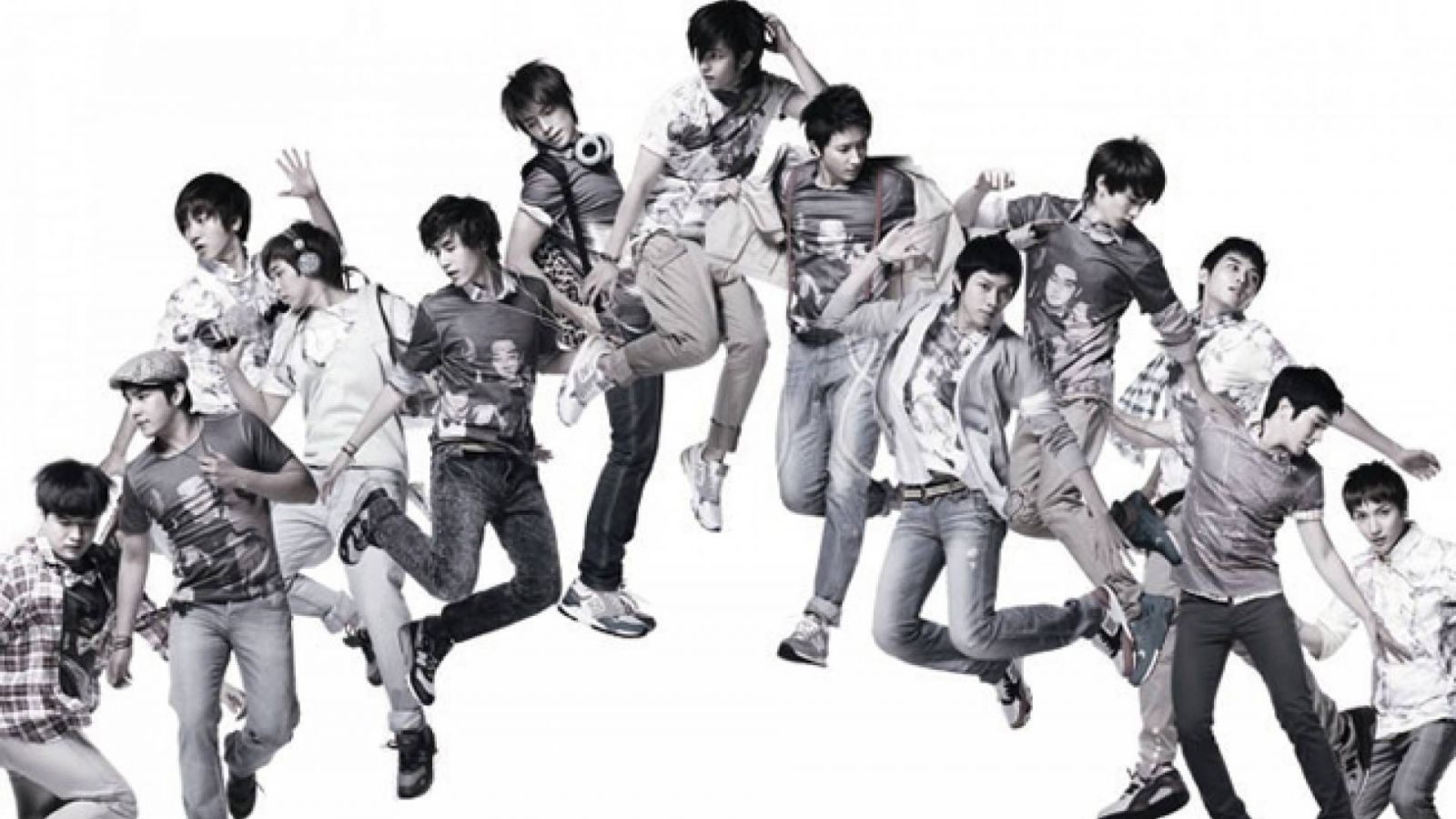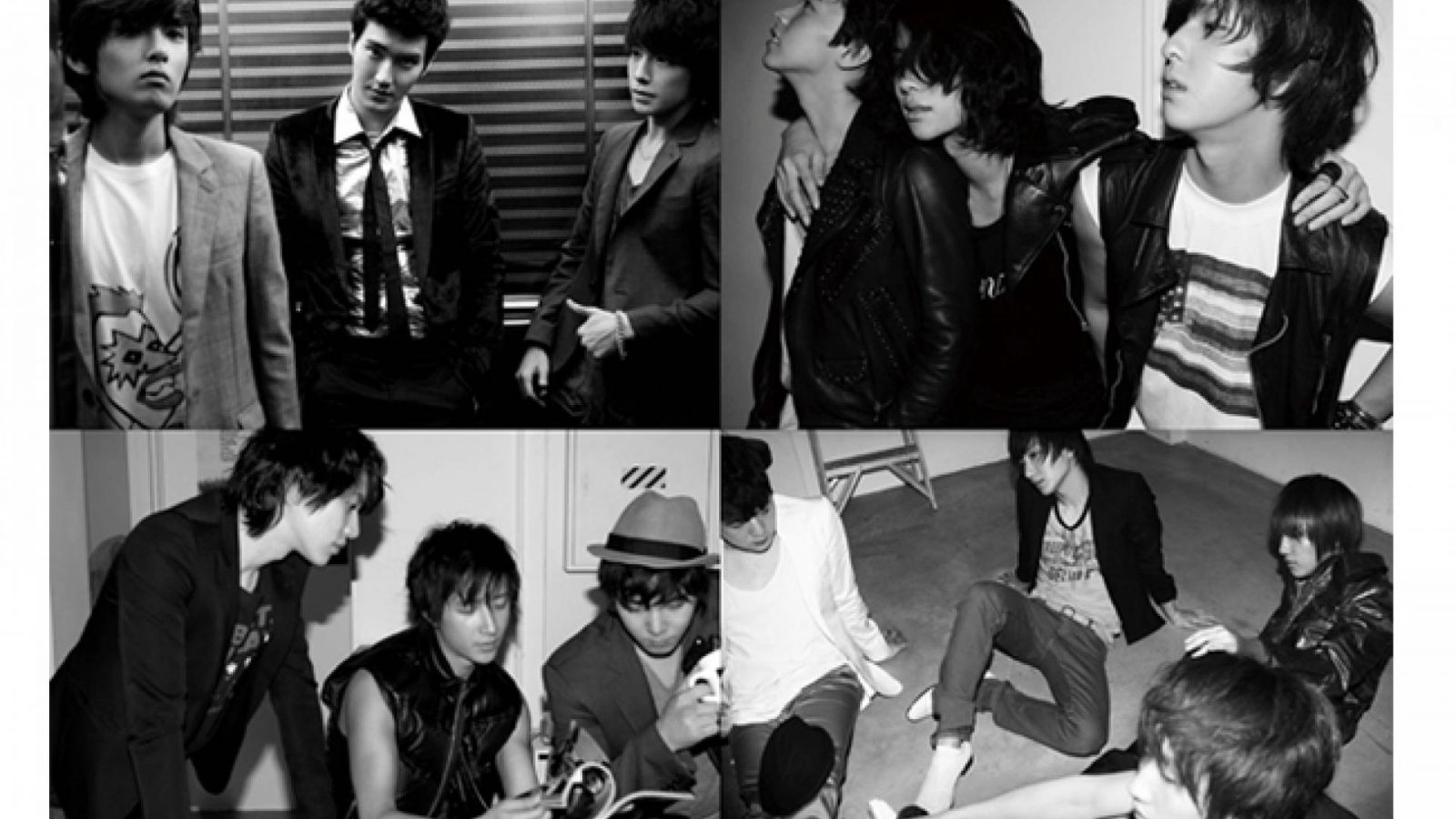Due to
Super Junior's unusually large size, there are naturally times when the whole group cannot perform together on the one stage, whether due to injuries or individual activities. In the formation of
Super Junior, SM Entertainment recognized this potential weakness and developed strategies to combat it, dissolving limitations that required
Super Junior to perform all the time with all 13 members, and at the same time, creating new ways to reach different audiences.
At the time of writing, there are four sub-units of
Super Junior, with each displaying different musical and marketing styles, and a different appeal to the general public.
Super Junior-K.R.Y.
Super Junior-K.R.Y. was the first sub-unit created. It is made up of three of
Super Junior's main vocalists -
Kyuhyun,
Ryeowook and
Yesung, with the name of the group created from the initials for each member's name. Focused specifically around the members' strong vocals,
Super Junior-K.R.Y.'s music consists mainly of R&B-inspired ballads, with the sub-unit as a whole appealing to an older audience than
Super Junior itself does.
Super Junior-K.R.Y. has not released an album to date, however, the group has performed in multiple drama OSTs, including
Hyena,
Snow Flower, and
Billy Jean, Look at Me. The sub-unit's activities mostly ground to a halt when member
Kyuhyun was hospitalized in the early part of 2007, and then were prevented from continuing after his comeback when both he and
Ryeowook were shifted into
Super Junior-M. However,
Super Junior's third album
Sorry, Sorry was somewhat of a comeback for this fan-favourite sub-unit, featuring two songs performed solely by its three members.
Super Junior-T
Super Junior-T, short for
Super Junior-Trot, is the second sub-unit from
Super Junior, made up of the members
Leeteuk,
Heechul,
Kangin,
Shindong,
Sungmin and
Eunhyuk. The group's objective is to renew the success of the original Korean pop style, Trot. In doing so, they are marketed to an older audience, but also have the task of presenting Trot music to the current generation of listeners.
Trot music was created before and during the Japanese invasion of Korea. Many Koreans describe Trot as synonymous to the Japanese traditional-style Enka, and indeed Trot is influenced by the Enka style. SM Entertainment's idea was to create a group that could recreate this style and release it into the modern charts, bringing back its success and popularity.
Super Junior-T mixes the traditional Trot sound with the more modern styles of pop and rap, accentuated with fun, casual lyrics. The group's first unofficial performance was on November 25th, 2006, on
M.NET/KM Music Festival, with the song
Na Kateungeon Obneun Keongayo (DON'T GO AWAY).
Super Junior member
Donghae was also featured in this performance.
The band's first single,
Rokuko, was released on February 23rd, 2007, with two b-sides, one of which featured the famous Trot singer
Bang Shilyi of the group
Seoul Sisters. The single reached number one on various Korean and Thai rankings and became the best-selling single of 2007, according to the Korean Music Industry Association. On November 5th, 2008, Super Junior-T made their debut in Japan with a Japanese version of the single, titled
Rock&Go or
65 (in Japanese, 6-5 is pronounced roku-go). The Japanese version of the song featured the Japanese comedy duo
Moeyan.
Super Junior-T was well accepted in Japan, with the single reaching 2nd place on the daily Oricon ranking and with giant banners of the band being displayed on buildings near the Shibuya Center, Japan's biggest shopping center.
You can watch the Korean version of the
Rokuko!!! (ROKUKO) music video by visiting the
band's official website.
Super Junior-M
Super Junior-M is the third
Super Junior sub-unit. In response to the increasing success of
Super Junior in China, SM Entertainment decided to create a sub-unit aiming specifically at the Chinese market.
The group's name was originally speculated to be
Super Junior-C or
Super Junior-China, however, the official announcement on October 2nd, 2007 named the group
Super Junior-M, standing not only for Mandarin, but also for the Chinese word Mi, meaning both charismatic and fan in Mandarin Chinese. It would also become the name of their second single.
Initially,
Super Junior member
Han Geng and Hong Kong-Canadian newcomer
Henry, whose violin solo featured in
Super Junior's
Don't Don, were announced as members. This initial announcement became part of a controversial issue amongst fans, some of who felt that adding a member or members who were not part of the main
Super Junior group was wrong, and unfair to the members who had worked hard to make the name a success so far.
Despite this, in early April of 2008, after several months of controversy and rumor surrounding the project, all seven members were announced to the public through a series of videos. As of April 8th, the members of
Super Junior-M -
Han Geng,
Siwon,
Donghae,
Kyuhyun,
Henry,
Ryeowook, and
Zhou Mi - appeared together in the group's first music video,
U, a new recording of the popular
Super Junior single. Their debut as a group at the
8th Annual Music Chart Awards was on the same day. The video for
U was a huge success for the new sub-unit, and was viewed over 1.4 million times in less than four days between China and Korea alone.
The first
Super Junior-M album,
Me, was released on April 23rd in China and May 2nd in Taiwan, while a special version featuring three bonus tracks sung in Korean was released on April 30th. Along with
U and the title track
Me, the album features a selection of tracks, including covers of
Super Junior songs and of the hit 2000
Sandy Lam song
At Least There's Still You as well as new tracks created specifically for the group. The album
Me achieved first place on the Amazon Music and Beijing Music rankings and third place on Top in Music Charts in China, as well as scoring first and second place on multiple other music charts.
Despite the controversy surrounding its creation,
Super Junior-M found great success, becoming one of the most popular bands in China, winning several major awards in 2008. The most notable of these was their Best Chinese Group award at the
9º CCTV-MTV Awards, one of the most important awards in the Chinese music industry.
The sub-unit is slated to continue its highly successful career after the end of
Super Junior's third album
Sorry, Sorry promotional activities, and it is expected that a new
Super Junior-M album will be released in 2009.
Super Junior-Happy
Super Junior-Happy, called
Super Junior-H by many fans, is the fourth sub-unit of
Super Junior. Officially announced by SM Entertainment on May 30th, 2008, this sub-unit features six of
Super Junior's members:
Leeteuk,
Yesung,
Kangin,
Shindong,
Sungmin and
Eunhyuk.
The band is called
Super Junior-Happy because their music tends towards dance-oriented bubblegum-pop, combined with happy, fun lyrics. With an aim to create happy feelings through their songs,
Super Junior-Happy is aimed at a comedy-loving, fun audience.
The band released their first EP,
Cooking? Cooking!, on June 5th, 2008, and their official debut was on June 7th on the
2008 Dream Concert. Their debut album reached first place on the Hanteo and MIAK K-Pop rankings in Korea and first place on the G-Music J-Pop ranking in Taiwan.
The music videos for the title track and first single
Cooking? Cooking! and the second single
Pajama Party can be seen on the
band's official website.







